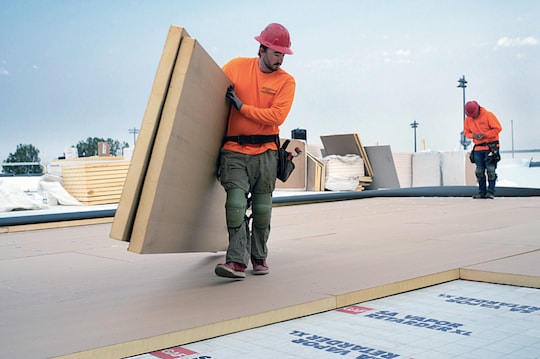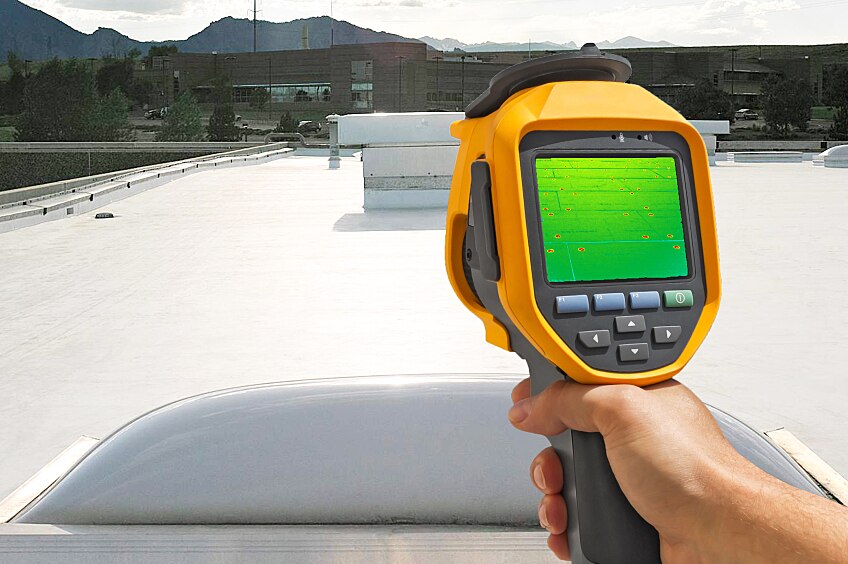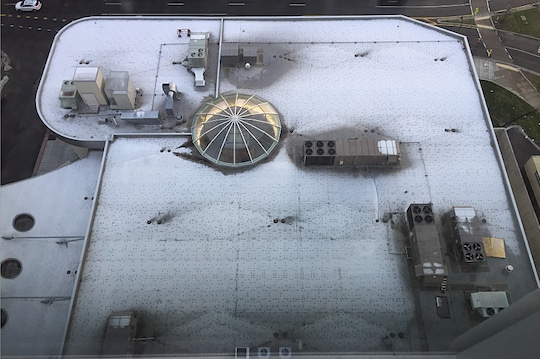
Until now, there has been surprisingly little research into the overall thermal impact of the fasteners that penetrate roofing insulation. A recent study shows that even relatively conservative use of fasteners creates enough thermal bridging between the roof deck and the insulation to substantially reduce the overall thermal performance of the building envelope.
Guest blogger Eric K. Olson, P.E. explains his research (Olson, Saldanha, and Hsu, "Thermal Performance Evaluation of Roofing Details to Improve Thermal Efficiency and Condensation Resistance," ASTM Roofing Research and Systems and Standards Development, Vol 8, STP 1590, ASTM International, November 2015)
Introduction
Thermal insulation in roofing systems plays a substantial role in the overall thermal performance of the building envelope. Energy code requirements for the R-value of the roofing insulation are becoming ever more stringent, requiring increased insulation thickness. Mechanical fasteners are commonly used to secure the insulation and roofing membrane to the structural roof deck.
Each metal fastener creates a thermal bridge that reduces the effectiveness of the insulation. For a single fastener, the impact would probably be negligible. A typical roof, though, may include thousands of fasteners. The effect of these myriad thermal bridges adds up. That is, the combined impact of the fasteners can substantially reduce thermal performance.
Considering the potential impact involved, there is surprisingly little information in the roofing industry regarding the overall thermal impact of fasteners on roofing insulation. To explore and help quantify these thermal impacts, some colleagues and I decided to perform and publish the results of three-dimensional computer heat flow models of fasteners and other roofing details that penetrate the roofing insulation (Olson, Saldanha, and Hsu, "Thermal Performance Evaluation of Roofing Details to Improve Thermal Efficiency and Condensation Resistance," ASTM Roofing Research and Systems and Standards Development, Vol 8, STP 1590, ASTM International, November 2015).

Thermal Bridging. Image by GAF.
Modeling and Analysis
We modeled a roofing system with 4 in. of polyisocyanurate insulation and 1/2 in. gypsum cover board with a nominal R-value of R-27.0, over steel deck, with the insulation fastened using steel plates and #14 roofing screws with a diameter of 0.214 in.
Modeling one fastener with plate penetrating a one sq. ft. area of insulation (e.g., sixteen fasteners per 4 ft. by 4 ft. insulation board), we found the following:
- Case 1: With the steel plate above the gypsum cover board, the fastener and plate drop the R-value from R-27.0 to R-19.2 (a 29% reduction in R-value).
- Case 2: Placing the plate beneath adhered gypsum cover board provides little improvement due to poor thermal resistance of the gypsum, raising the R-value from R-19.2 to R-19.5.
Swapping out the gypsum cover board with 1/2 in. high-density polyisocyanurate cover board raises the nominal R-value of the system from R-27.0 to R-29.0. Repeating the above analysis, we found the following:
- Case 3: With the steel plate above the polyisocyanurate cover board, the fastener and plate drop the R-value from R-29.0 to R-21.2. This is a 27% reduction in R-value as compared to the nominal R-value using polyisocyanurate cover board.
- Case 4: Placing the plate beneath adhered high-density polyisocyanurate cover board raises the R-value from R-21.2 to R-23.8. This is a 9% improvement as compared to the case with the plate on top of the polyisocyanurate cover board, but still an 18% reduction as compared to the nominal R-value using polyisocyanurate cover board.
The above cases represent high rates of fastening (one per sq. ft.) that may be encountered at corners or perimeter zones. In practice, field-of-roof zones require fewer fasteners and have greater area, and thus have a greater influence on thermal performance than corner and perimeter zones. The figure below graphs the effective R-value versus the number of evenly spaced #12 fasteners and steel plates per 4 ft. x 4 ft. insulation board, using the conditions of Case 1 (fasteners through and plates above gypsum cover board) above.
Change in effective R-value Relative to Number of Fasteners for Case 1
As can be seen above, the thermal bridging created by even light fastening rates can be significant. A pattern of five fasteners per board, frequently seen in field areas of a roof, drops the effective R-value to R-24. This is an 11% reduction in R-value.
Our work to date indicates that mechanically fastening roofing insulation substantially reduces the roof's thermal performance as compared to a similar system without fasteners. More work remains to be done to quantify thermal bridging through roofing systems. The influence of fastener diameter, the use of less conductive fasteners (like stainless steel), and the use of polymer plates in reducing thermal bridging should be explored.
A better understanding of these thermally bridging elements will help identify options to help mitigate their effect. This, in turn, will help designers to better specify the thermal performance characteristics of their roofing systems.



